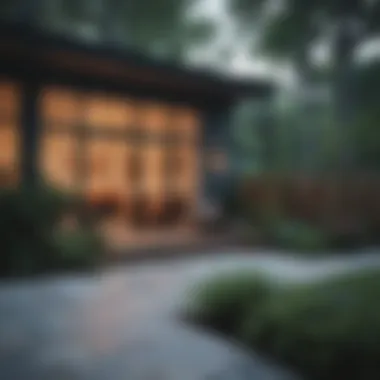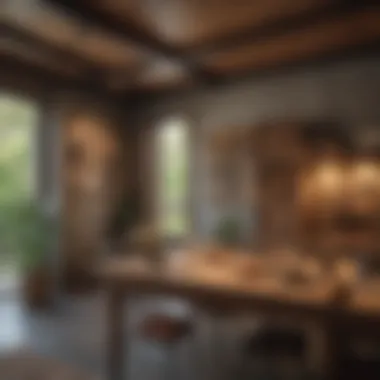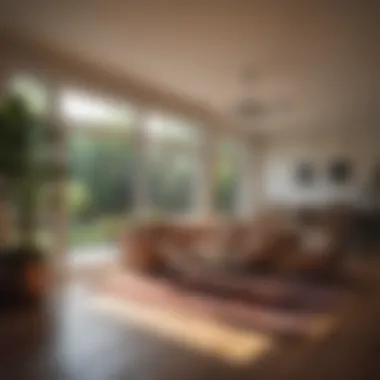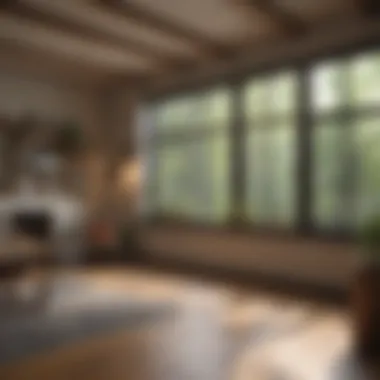Understanding Home Addition Costs: Price Per Square Foot


Intro
Understanding the price per square foot for home additions is crucial for homeowners considering expanding their living space. This metric serves as a foundation for budgeting and helps homeowners compare costs effectively. Factors such as location, materials, and design choices greatly influence this price, making it essential to grasp these elements before committing to any plans.
From a functional perspective, home additions can take many forms, such as extra bedrooms, enhanced kitchens, or additional bathrooms. Each type of addition begs the question: how do costs differ? Not only do these costs affect how much money you will need to save, but they also impact the future value of your property. The better informed you are, the more empowered you will feel in making decisions that align with both your financial goals and lifestyle needs.
This article aims to provide an exhaustive overview of essential aspects concerning costs and factors influencing home additions. By outlining various types of additions, exploring budgeting techniques, and evaluating return on investment, readers will gain valuable insights into navigating this often complex process.
Design Inspirations
When undertaking a home addition, design plays an essential role in ensuring the new space seamlessly integrates with the existing structure. Homeowners should reflect not only on aesthetics but also on functionality.
Trending Styles
The current trend leans towards open concept designs, which promote airflow and natural light. Many homeowners opt for larger windows or even skylights, creating an airy and spacious feel. Modern minimalist approaches have also gained traction, emphasizing clean lines and uncluttered spaces.
Natural materials are becoming popular, with wood, stone, and metals being favored for their timeless appeal and durability. Incorporating elements like exposed beams or brick can add character while also remaining practical. Here are a few prevalent styles:
- Contemporary: Clean lines and functional layouts.
- Rustic: Use of natural materials, often rustic finishes.
- Mid-century modern: Simple forms, vibrant colors, and integration with nature.
Color Palettes
Color selection can significantly influence the ambiance of a new space. Neutral palettes dominate the current market, providing a versatile backdrop that allows for personalization with decor. However, bold accent colors can be strategically used to create focal points within your addition. Popular options include:
- Soft grays and whites for a clean, modern feel.
- Earthy tones like terracotta and olive green for a more nature-inspired vibe.
- Pops of color in furniture or decor to enhance features without overshadowing.
Choosing the right colors and designs can make a profound difference in how a new addition feels and functions.
Maintenance and Upkeep
Adding new space means acknowledging the maintenance required to keep that space in good condition. Regular upkeep minimizes repair costs in the long run.
Seasonal Maintenance Checklist
- Inspect roofing and gutters to prevent water damage.
- Seal windows and doors to maintain energy efficiency.
- Check HVAC systems before heating or cooling seasons.
Cleaning and Organization Tips
Designing storage solutions into your addition can also maximize usable space. This may include built-in shelving or cabinets. Regular decluttering promotes organization, ensuring that your new area remains functional and inviting.
"Proper maintenance will not only enhance aesthetics but also prolong the life of the addition."
In summary, understanding the price per square foot for various types of home additions requires consideration of multiple factors. Design inspirations guide the aesthetic and functional choices, while maintaining the new space ensures its longevity and value. Through careful planning and consideration, homeowners can make informed decisions that align with their vision and budget.
Foreword to Home Additions
Home additions are a significant consideration for many homeowners looking to enhance their living space. This aspect of home improvement involves updating a residence, which can provide more room, functionality, and even increase property value. Understanding the dynamics of home additions is crucial, especially how to assess costs effectively. Making an informed decision can save time, money, and potential stress.
Defining Home Additions
Home additions refer to the physical extension of a dwelling. It can include expanding existing rooms or creating entirely new spaces. Common types of additions are extra bedrooms, bathrooms, or more open living areas. Homeowners may also venture into outdoor expansions such as decks or sunrooms. Each type presents unique challenges, implications in cost, and potential impact on the overall structure.
Importance of Cost Analysis
A thorough cost analysis is pivotal in the planning stages of any home addition project. Failing to analyze the cost per square foot can lead to budgeting issues and unexpected expenses. Being proactive in understanding costs contributes to a successful renovation. Accurate cost assessment ensures the project remains within budget while meeting expected standards and quality. Ultimately, conducting this analysis promotes smarter financial decisions, influencing investments in home properties for maximum return.


Overall, navigating the landscape of home additions requires an informed approach. The need for strategic cost analysis cannot be overstated, as it lays the groundwork for a project that is not only successful but also provides lasting satisfaction and financial prudence.
Understanding the Price per Square Foot
Understanding the price per square foot for home additions is crucial for homeowners considering expansion. This metric provides a standardized way to estimate costs, facilitating clearer comparisons across different projects and locations. Factors like local market conditions, materials used, and labor availability all intertwine to establish this figure. Moreover, comprehending the price per square foot can help homeowners allocate their budgets effectively, prioritizing quality and design without overspending. It is a foundational aspect of home improvement that warrants careful consideration.
Basic Calculation Methods
Calculating the price per square foot involves dividing the total cost of the addition by its total square footage. For example, if a home addition costs $40,000 and has an area of 800 square feet, the calculation would be:
[
This means the cost per square foot is $50. Understanding this basic calculation not only aids in budgeting but also provides clarity when reviewing quotes from contractors.
Factors Influencing Cost
Several factors affect the price per square foot for home additions. Knowing them allows homeowners to anticipate potential costs accurately and make informed decisions.
Location
The location of a home plays a significant role. Urban areas typically have higher costs due to demand and living expenses. Rural locations, on the other hand, might present lower costs because of less competition and lower demand. Each location carries its own set of advantages and disadvantages; for instance, urban locations offer proximity to amenities but come at a premium. Understanding local market trends and economic conditions can greatly assist in predicting addition costs.
Material Quality
The quality of materials can greatly affect the overall project cost. High-quality materials, though more expensive upfront, often lead to better durability and longer lifespans for home additions. While lower-quality materials may save money initially, they can incur future replacement costs. Homeowners should balance the need for aesthetics and functionality when selecting materials, ensuring they match their long-term vision for the space.
Labor Costs
Labor costs are another key factor in determining the price per square foot. This cost can vary widely based on location, complexity of the project, and local labor market conditions. Skilled labor often commands higher wages, reflecting their expertise. Homeowners should consider these expenses in their budgeting, ensuring they engage reliable contractors who provide value. It is advisable to obtain multiple quotes before settling on a contractor to ensure competitive pricing.
Design Complexity
Design complexity can significantly impact costs as well. Straightforward additions may follow standard labor and material requirements, while intricate designs can increase both time and resources required. Custom designs may even lead to unforeseen costs if complications arise during construction. Homeowners should discuss their design preferences openly with contractors, ensuring they understand how these choices influence overall project costs.
Types of Home Additions
When considering home expansion, understanding the types of home additions is fundamental. This section provides clarity on various options available. Each type comes with its own set of benefits and considerations, which can significantly impact the overall cost and functionality of a home. By examining these factors, homeowners can make informed decisions that align with their needs and financial situation.
Single-Story vs. Multi-Story Additions
Single-story additions are generally less expensive and easier to construct compared to multi-story ones. They also require less structural reinforcement, as there is no additional weight on the existing foundation. However, multi-story additions can provide more living space without expanding the home's footprint. This is advantageous for smaller lots where space is limited. Homeowners must weigh the cost against their long-term needs, aesthetics, and compliance with local regulations.
Room Expansions
Bedrooms
Adding a bedroom can significantly increase a home's value. This type of addition can accommodate growing families or create guest space. A key characteristic of bedroom additions is their flexibility in size and design; they can be small and simple or large and elaborate. A unique feature is the possibility of converting unused space, such as attics or basements, into bedrooms. However, depending on local codes, these conversions may require extensive remodeling.
Bathrooms
Expanding bathrooms is often necessary as family sizes grow or when hosts have guests. Bathrooms are essential for daily routines, and having more than one can minimize congestion during peak times. The main characteristic is the range of options available, from simple powder rooms to luxurious spa-like settings. A unique feature of bathrooms is the potential for high return on investment. However, plumbing upgrades may add to overall costs, which is an essential consideration.
Living Spaces
Room expansions in living spaces enhance comfort and functionality. Whether it is a family room, den, or game room, these additions can cater to various needs. A key characteristic of living spaces is their social utility; they become gathering areas for families and friends. Unique features include the integration of technology or eco-friendly options depending on homeowner preferences. While valuable, these expansions can involve significant costs, especially if structural changes are needed.
Kitchens


Kitchens are often referred to as the heart of the home. An expansion can provide improved workflow, additional storage, and more seating options. Key characteristics include multi-functionality; expanded kitchens can serve as cooking areas and social hubs. Homeowners might choose to keep the current kitchen layout or opt for open-concept designs. Unique features in kitchen additions may include smart appliances and energy-efficient systems. Having to reroute plumbing and electrical wiring can lead to elevated expenses.
Outdoor Spaces
Decks and Patios
Adding outdoor spaces, such as decks and patios, greatly extends living areas. These spaces are ideal for relaxation and entertainment. The key characteristic is versatility; they can be simple or designed with elaborate features like kitchens or fire pits. Unique features may include utilizing sustainable materials, which not only appeal to eco-conscious homeowners but may also reduce maintenance costs. However, proper permits and local regulations must be considered, as they can impact timelines and costs.
Sunrooms
Sunrooms allow for enjoyment of natural light and views while providing shelter from the elements. The main benefit is versatility; they can serve as living spaces, greenhouses, or home offices. A unique feature is that they can enhance a home’s aesthetic appeal and energy efficiency if designed with the right materials. Cost considerations include foundation work and insulation, which are essential for climate adaptability.
Garages
Garages can be a critical addition, providing excellent functionality for vehicle storage and protection from the weather. They can also serve other purposes, such as workshops or storage areas. The key characteristic of garages is their security benefit; they offer peace of mind for homeowners. Designing a garage with additional storage solutions can enhance value. However, costs can escalate with custom features or attached garages that require more structural work.
Home additions, such as room expansions and outdoor spaces, can enrich both functionality and property value, but require careful consideration of costs and planning.
Assessing the price per square foot for these particular types of additions is crucial for effective budgeting and planning.
Budgeting for Home Additions
Budgeting for home additions is a crucial aspect of the overall planning process. Without a clear financial plan, homeowners can encounter unexpected costs, mismanage funds, or even halt construction. Establishing a solid budget helps to align expectations with reality. Travelers on this journey must navigate various financial factors—these include materials, labor, permits, and design elements. Each of these factors contributes to the overall price per square foot, impacting the total expenditure on the project.
A well-structured budget acts not only as a financial guideline but also as a tool for making informed decisions. For instance, understanding which materials are within budget can help homeowners avoid costly last-minute changes. Further, a realistic budget allows for better communication with contractors. This clarity reduces the chances of disputes over payments or scope creep, enabling a smoother process overall. Other benefits include improved project timelines and increased satisfaction during and after the completion of the addition.
Overall, budgeting is not just about limiting spending. It is about crafting a vision for your home that can be realized within financial means, leading to a successful home addition project.
Establishing a Realistic Budget
Establishing a realistic budget involves careful planning and thorough research. Homeowners should begin by assessing their finances and determining how much they can afford to allocate to a home addition. This involves calculating available savings, considering any loans or financing options, and understanding estimates available in their market.
When determining the budget, it is critical to break it down into components:
- Materials: Identify what types of materials you prefer and research their costs. This includes everything from flooring to roofing.
- Labor: Understand the labor costs involved. Hiring experienced contractors may be more expensive upfront but can save money over time through quality work.
- Permits and Fees: Remember to factor in necessary permits. These costs can add up quickly and vary greatly by region.
- Design Fees: If you plan to hire a designer, include their fees in your budget from the start.
Using these categories, homeowners can create a detailed framework that lays the groundwork for financial planning. Always remember to keep detailed records of estimates provided by contractors and suppliers, as these will be helpful when making final decisions.
Moreover, being flexible and adjusting your budget as needed during the planning phase is important. The goal is to ensure that your aspiration for an addition fits within the practical confines of your financial capabilities.
Contingency Funds
Contingency funds are essential in any budget for home renovations or additions. This fund acts as a safety net, covering any unexpected expenses that arise during the project. These unplanned costs can stem from various sources, such as fluctuating material prices, labor issues, or unforeseen structural problems uncovered during construction.
It is commonly advised to allocate about 10-20% of the total budget for contingencies. This percentage can help manage risks associated with construction projects. Understanding that surprises may happen is critical to effectively preparing for them.
A contingency fund allows for flexibility and peace of mind, reducing stress during the renovation process.
Return on Investment Considerations
To maximize ROI, several specific elements must be considered. First, the quality of construction plays a crucial role. High-quality materials and skilled labor usually translate to higher property values. Secondly, the purpose of the addition matters. For instance, adding functional spaces like bedrooms or bathrooms generally offers better returns than luxury features without practical value. Understanding the local market dynamics can also guide decisions. A well-planned addition should align with buyer expectations in the area, which can significantly affect ROI.
Furthermore, homeowners should assess the timeframe for recouping the investment. Real estate trends tend to fluctuate. Being aware of long-term market stability versus short-term volatility can inform whether now is the right time to invest. A calculated approach benefits in knowing when to expand, how much value to anticipate, and whether the undertaking aligns with the owner's financial goals.
"Investing wisely in home additions not only enhances living space but also fortifies the property value in turbulent markets."


By taking these considerations into account, homeowners can approach their projects with a clearer understanding of the potential return.
Market Trends Impacting ROI
Market trends profoundly influence the ROI of home additions. Various economic factors determine how much value an addition can bring:
- Interest Rates: Lower rates can lead to increased buyer activity. More demand can elevate home values, enhancing the ROI for additions.
- Local Economy: Regions with strong job markets and economic growth generally see rising property values. Investing in home additions in such areas may yield better returns.
- Real Estate Availability: In markets where housing supply is low, home improvements can significantly increase a property's value. Homeowners might experience faster ROI in such scenarios.
Homeowners should keep abreast of market conditions and tailor their projects accordingly. It may be wise to consult local real estate experts or conduct research on recent sales to understand how similar additions have performed financially.
Comparative Analysis of Additions
To truly gauge the potential ROI of a home addition, it is essential to undertake a comparative analysis. This involves examining various types of additions and their respective impacts on property value. Some critical factors include:
- Nature of the Addition:
- Size and Scale: Larger additions can offer greater value but also require careful budget considerations. The cost per square foot can vary notably, influencing return timing.
- Design Considerations: Modern designs that appeal to current trends often attract higher interest from potential buyers, impacting overall value.
- Seasonal Trends: Adding or renovating during peak buying seasons can increase ROI. Buyers are typically more active in spring and summer.
- Extra Bedrooms: Generally, bedrooms add significant value, especially in family-oriented neighborhoods.
- Bathrooms: A well-placed bathroom often yields a high return, as it can enhance livability and convenience.
- Kitchens: High-quality kitchen upgrades can attract buyers, significantly increasing ROI.
By conducting a thorough comparative analysis of different types of additions, homeowners will be better prepared to make sound investment choices that align their desires with market expectations.
Regional Variability in Pricing
Understanding regional variability in pricing is crucial for homeowners considering additions to their properties. This aspect influences not just the overall cost of a project but also the nuances that define the construction landscape. This section will evaluate the differing costs associated with urban and rural settings, as well as provide a state-by-state analysis that takes into account local economies and market conditions. The variability is a reflection of local demands, resource availability, and labor costs that can fluctuate significantly across different regions.
The significance of addressing regional variability cannot be understated. Homeowners must assess local real estate trends and community needs when planning their expansions. By understanding the regional factors impacting costs, homeowners can make more informed decisions that align with their budgets and expectations. This will ensure that their investment yields the best possible outcomes in terms of value and satisfaction.
Urban vs. Rural Costs
Urban areas typically experience higher costs per square foot for home additions due to several interrelated factors. Larger populations create higher demand for housing, which leads to increased competition among contractors, accordingly raising labor prices. Materials also tend to be more expensive in cities due to transportation costs and logistical challenges associated with urban environments. Furthermore, larger cities often enforce stricter building codes, necessitating specialized expertise and compliance, which can drive up both labor and material prices.
"Costs in urban areas can exceed those of rural locations, but the trade-off is often access to better amenities and services."
In contrast, rural areas benefit from lower housing demand and generally lower labor costs. Here, contractors have more competitive pricing, and materials often incur lower transportation fees since distances are shorter. However, relying on local contractors may limit options, which can affect the availability of skilled labor or quality materials. Overall, homeowners in rural settings may find that while the base price per square foot is lower, the range of services and expertise might not match what is available in urban markets.
State-by-State Price Analysis
A thorough understanding of state-by-state price differences is necessary for evaluating home addition costs accurately. Each state has unique factors influencing its market dynamics. For example, construction costs in states like California and New York are significantly higher than in states like Arkansas or West Virginia. Several elements contribute to this disparity:
- Local Economy: States with booming economies, such as Texas, often see a higher demand for housing, leading to increased construction costs.
- Regulations and Permits: Areas with strict zoning laws or building regulations may force contractors to charge higher fees to meet compliance standards.
- Seasonal Weather Patterns: In northern states, the limited construction window due to harsh winters can impact availability and pricing for labor and materials.
It's essential for homeowners to research and compare these trends, as they can reveal substantial insights. Online resources can be beneficial, providing access to local construction surveys and homeowner reviews.
Homeowners should also consult local real estate agents, builders, or community forums like reddit.com for firsthand experiences with pricing and quality of home additions in specific areas.
By properly assessing these regional factors, homeowners can navigate the complexities of home addition costs with greater efficacy. This understanding ultimately allows for smarter financial choices and better alignment of expectations with the realities of home expansion.
The End
In navigating the complexities of home additions, the importance of assessing the price per square foot cannot be overstated. This article has illuminated various factors that significantly impact costs, making it essential for homeowners to grasp these elements before embarking on expansion efforts.
An informed approach aids in budgeting effectively, helping owners avoid unexpected expenses that could sour the experience of creating their dream space. The analysis of price variations also offers insight into the economic climate of home construction. Understanding regional differences can guide decisions on whether to pursue certain additions or consider alternatives.
Furthermore, recognizing the return on investment is crucial. Each addition, while enhancing living space, also impacts property value. As homeowners consider their choices, they should weigh these financial implications against personal needs and lifestyle enhancements.
Ultimately, this culmination of insights points to one key takeaway: knowledge provides power. Homeowners equipped with detailed information about costs and considerations can make better, more confident decisions that align with their objectives for improving and expanding their home.
Key Takeaways
- Assessing price per square foot is fundamental in planning home additions.
- Adequate budgeting helps avoid unexpected financial burdens.
- Understanding regional cost differences is crucial for informed decision-making.
- Analyzing return on investment helps align expansions with financial goals.
- Knowledge enables homeowners to make confident choices and maximize property value.
"Knowledge is a tool; it shapes the process of designing the future of your home."
By embracing this valuable information, readers can proceed with their home addition projects more effectively and strategically.







